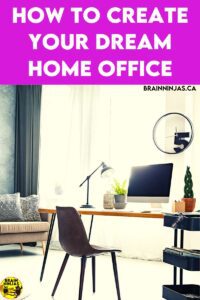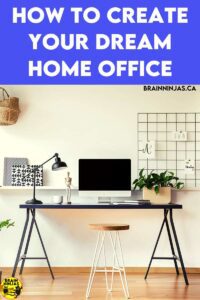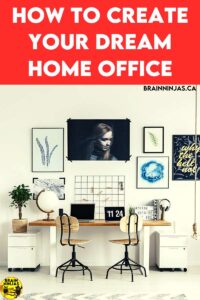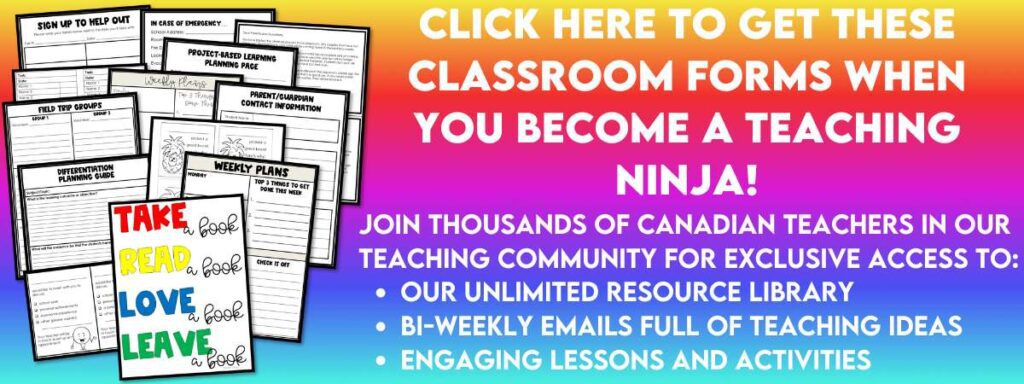
When you work from home, do you have an actual office or are you like so many teachers piling things high on the dining room table or the living couch?
That strategy works, but after a while it can take a toll. We all need a safe, reliable space to work in, but that doesn’t mean you have to break the bank.
Here are some things to consider when designing your own home office.
Where will your home office be?

Is your office going to be its own room or will you be carving out the space from another room? There is no right or wrong way to decide, but think about the work you’ll need to be doing and how much space that will take. Think about whether you’ll need to stand or sit. Think about whether you’ll have a desk or not. The space will need to fit for your work.
Will your office be in your home? Maybe a she-shed out in the backyard is right for you? Do you have a small trailer out in the back forty? Maybe you’ve planted an old shipping container in the driveway.
And if you make a she-shed, PLEASE send us some pictures as we are always trying to convince the Mr. Ninjas that this would be a great option.
Think about the traffic in your household when you’re designing your space. Will there be constant distractions with people coming and going? Are you able to leave work in progress without a pet or child getting a hold of it and eating it? Will you be able to step away from your work without having to pack up your space so it can be used for something else (like having dinner on your desk)?
The space you work in, is the most important factor. Everything else depends on where you work, so make your decision wisely.
What type of desk will you need?

There is lots of talk about sitting versus standing desks. I’ve tried both and I don’t think I have a preference except that for things I’m doing that require a steady hand, I prefer to sit. Either way, experts agree that too much sitting or too much standing is unhealthy. Maybe the best option is one that can be both.
We’ve been asked before to provide our suggestion, but honestly, we haven’t found one that’s right for home office use. We have several at school, but they are quite industrial and cost a small fortune (which honestly doesn’t seem worth it for the look of them). If you have a create one, please let us know.
In the past we’ve used tables, but they are often too big for the space. One ninja created a standing desk of her own by adding a wooden top across a set of small IKEA shelves. It is working for her and it does have a lot of storage. The other ninja purchased a modular desk (where you pick out all the parts and put it together yourself). It has worked, but it’s a big desk so now there’s a whole room office.
Ergonomics matter, but they matter more if you will be using the desk for long periods of time every day. Long-term repetitive motions like mouse clicking and typing can cause harm if the space you’re working keeps your hands or wrists in unnatural positions. If you’re finding that you get sore at the end of your work time, you may need to change how you’re working. You may need to take small breaks more often, do exercises to stretch, change your workspace or find a more ergonomically compatible keyboard, mouse or chair.
If you are choosing a sitting desk, you’ll need to consider the type of chair you’ll need. It should be comfortable, at the right height for your tabletop and should consider the flooring in your space. Personally, rolling chairs on the carpet are annoying, but if the wheels are “too rolly” on a hard floor, I find the chair slowly inching away from the deck as I work. It’s annoying too.
I’m not picky about chairs, but some people are. Think about the fabric, the armrests, the back support, the neck support and the cost. You might need to plant your butt in a few in-stores to find the one you like.
And don’t be surprised when the best chair you find is at a neighbour’s yard sale for $10. True story!
Where will you store everything?

Storage space is a continual problem. There are lots of shelves and boxes out there, but are they functional for the space you’ll be using? Will there be enough drawers to store all the sticky notes? Where will all the pens go? You cannot be a teacher and not have a disproportionate amount of stationary, so you need to think about where you’ll keep all of that.
Depending on how much of a pack rat you art, your storage solutions can help or hinder your organization. Large drawers can become dumping grounds for things you’ll forget about and find way after you needed it. Too many small drawers can cause frustration with having to look through every drawer to find the one thing you want.
So, you need enough storage to hold the things you want to keep, but not so much that you keep things you don’t need.
Labels are your friend. They don’t need to be huge, colourful or professionally designed. A simple label maker can be an effective way to write a simple description on each drawer. This makes it easy to know what to put in each drawer and to find things when you need them.
If you have a small desktop, you’ll want to keep the majority of your items off your desk surface. Wall storage might be the answer for you. One of the best purchases I ever made was a peg board system from IKEA. It has lots of different-sized open containers. All of the materials I use daily are on this peg board just above my desk for easy access. Clean-up after a project is quick because I just return the items to peg board.
Keep like items together. This seems like an obvious storage solution, but sometimes when the space you’re working in has a lot of storage the items can get mixed up. Case and point: coloured printer paper. One rainy summer day I decided to sort through my colour printer paper to see if I needed any colours during the upcoming sale (because I hunt paper sales like regular people hunt shoes). I dug through every drawer and put all the paper on my desktop to see what I had. That was the day I knew I had a problem. I didn’t need any more paper-in fact I had multiple duplicate packages and immediately banned myself from buying more paper. It’s been almost two years and I still haven’t run out.
The same can be said for sticky notes.
And pens.
Yeah, I should seek help.
What about the computer or printer?

If you’re going to use a computer or a printer, you’ll need to think about how these are stored and whether or not they’ll have electrical power when needed. It isn’t very convenient to have to dig around and move everything every time you want to print something, so we recommend finding a secure place for your printer to live. Make sure any connection cables that are needed regularly are accessible. We have ours taped to the side of the printer (only because the wifi printing option never seems to work and it’s just faster to plug the laptop directly into the printer).
If you have a printer, you likely have ink cartridges and printer paper piled somewhere. Try to build those into your storage solutions and keep them near the printer so you won’t have to look for them.
We guarantee that you will run out of ink and or paper when you’re in a hurry so having things organized will safe you time and save your sanity when that day comes.
And then there’s the teacher stuff…
Teacher stuff takes up more space than you’ll ever think.
My husband gifted me with this beautiful wooden filing cabinet when I graduated with my education degree. It has two drawers. After my first year of teaching, I learned that a filing cabinet wasn’t going to cut it.
Now, the digital age has helped IMMENSELY. I no longer keep every single piece of paper thanks to a scanner and digital apps on my phone. If you want to learn more about how I did it, you should read Clean the Clutter, or a Clean the Clutter checklist can be found in our Resource Library, along with many other general classroom forms to help you organize your classroom. Or we can send a copy directly to your inbox when you sign up for our email list.
I also learned that I don’t need to keep every single thing I might teach one day, because when there’s all that stuff, it’s too much work to go through it all to find that one thing. The internet has also changed this process. It’s so much faster to search my computer or online. Just make sure you label your digital scans well so you can find them later.
I’m not a scrapbooker-at least not in the traditional sense. The idea sounds like fun but frankly, it’s just not my think. But, I did buy one of those big scrapbooks to keep notes, cards, drawings and photographs of students. It’s one place to keep all those momentos. I’ve had to get a second book, but they both sit neatly on my shelf instead of all over the place like they used to.
As for all the teacher manuals and resources I’ve had to purchase over the years, I had to resort to nicely labeled boxes. I no longer take every resource I own to school. I’ve found that it works much better to just take the resources I’m using when I need them. When I return them to my office they already have a place to live. If I find that I’m not using a resource, I get rid of it. There is no point in hanging on to those things that are using up my storage space. If you’re freaking out about that, you really should read Clean the Clutter.
As for all the student samples, gifts and things that don’t fit into boxes, well, they need some creative storage. I have a few small shelves where gifts can be displayed and a little wall space where I hang some of the items. Sometimes when a gift can no longer live in the space I will pack it away and then switch things out from time to time. Sometimes I photograph them, put them in my scrapbook and then pass it along (usually to a garbage can-gotta love all those homemade things).
What about decorating?
Sometimes people create a space just so they can decorate it. We are not those people. We’re just not into it. But that’s perfectly ok if you are. Go for it. Make the space your own and love it.
What kind of workspace do you have at home? What organizational strategies have you used to help you stay on track? Share your thoughts with us in the comments below. We’d love to see your home offices.







